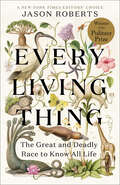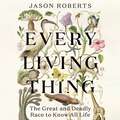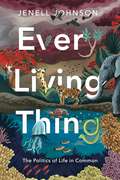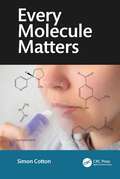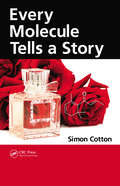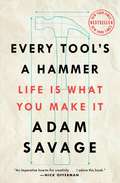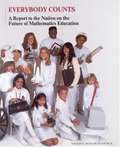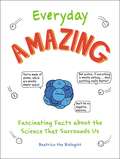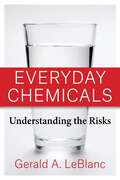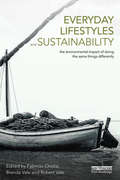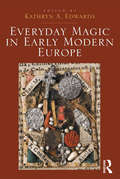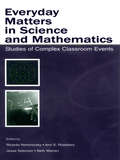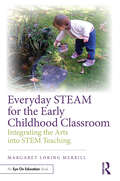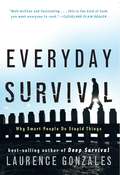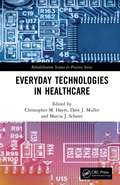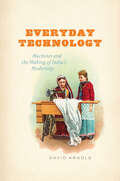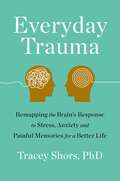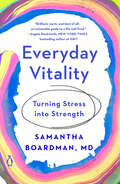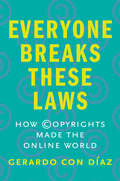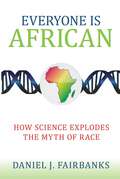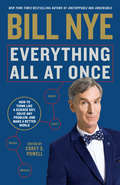- Table View
- List View
Every Living Thing: The Great and Deadly Race to Know All Life
by Jason RobertsPULITZER PRIZE WINNER • An epic, extraordinary account of scientific rivalry and obsession in the quest to survey all of life on Earth&“[An] engaging and thought-provoking book, one focused on the theatrical politics and often deeply troubling science that shape our definitions of life on Earth.&”—The New York Times&“A fluent and engaging account of the eighteenth-century origins of Darwinism before Darwin.&”—The Wall Street Journal WINNER OF THE PEN/E.O. WILSON LITERARY SCIENCE WRITING AWARD • A KIRKUS REVIEWS BEST BOOK OF THE YEARIn the eighteenth century, two men—exact contemporaries and polar opposites—dedicated their lives to the same daunting task: identifying and describing all life on Earth. Carl Linnaeus, a pious Swedish doctor with a huckster&’s flair, believed that life belonged in tidy, static categories. Georges-Louis de Buffon, an aristocratic polymath and keeper of France&’s royal garden, viewed life as a dynamic swirl of complexities. Each began his task believing it to be difficult but not impossible: How could the planet possibly hold more than a few thousand species—or as many could fit on Noah&’s Ark?Both fell far short of their goal, but in the process they articulated starkly divergent views on nature, the future of the Earth, and humanity itself. Linnaeus gave the world such concepts as mammal, primate, and Homo sapiens, but he also denied that species change and he promulgated racist pseudoscience. Buffon formulated early prototypes of evolution and genetics, warned of global climate change, and argued passionately against prejudice. The clash of their conflicting worldviews continued well after their deaths, as their successors contended for dominance in the emerging science that came to be called biology.In Every Living Thing, Jason Roberts weaves a sweeping, unforgettable narrative spell, exploring the intertwined lives and legacies of Linnaeus and Buffon—as well as the groundbreaking, often fatal adventures of their acolytes—to trace an arc of insight and discovery that extends across three centuries into the present day.
Every Living Thing: The Great and Deadly Race to Know All Life (WINNER OF THE 2025 PULITZER PRIZE FOR BIOGRAPHY)
by Jason RobertsAn exploration of two geniuses with limitless minds and the conflict that has lasted beyond their lifetimes.Every Living Thing centres on the rivalry pledged between two scientists, Linnaeus and Buffon, who, from 1743 to 1778 raced each other to complete an inventory of all life on Earth. Their focus was on scientific immortality and the core conception of our relationship to the natural world. Their catalogues were starkly different and showed a divergence of opinion on the creation of nature and humanity. Buffon advocating for a natural system of classification, while Linnaeus was dedicated to naming and classifying objects of nature. This book coins this competition the Nature Wars, and combines comprehensive narrative, interweaving the personal journeys of Linnaeus and Buffon, telling their moments of accomplishment and loss, persistence and sacrifice. Reflecting on this rivalry, Every Living Thing confronts how the Nature Wars are still being waged today. Current innovations in science and technology, as artificial intelligence seeps into our daily lives and modern DNA labs are forcing us to reconsider the legacies of these great thinkers, and with this, re-imagine our relationship to the natural world.Every Living Thing is an enthralling account of historic rivals who were forced to comes to terms with the vast and complex reality of life on Earth, exploring the evolution of science from the 18th Century to the present times, it tells of the displacement that has occurred as new discoveries create dramatic shifts in the mechanisms of the world.
Every Living Thing: The Politics of Life in Common (RSA Series in Transdisciplinary Rhetoric)
by Jenell JohnsonThis book examines the question of what we mean when we talk about life, revealing new insights into what life is, what it does, and why it matters. Jenell Johnson studies arguments on behalf of life—not just of the human or animal variety, but all life. She considers, for example, the Standing Rock Sioux tribe’s fight for water, deep ecologists’ Earth First! activism, the Voluntary Human Extinction Movement, and astrophysicists’ positions on Martian microbes. What she reveals is that this advocacy—vital advocacy—expands our view of what counts as life and shows us what it would mean for the moral standing of human life to be extended to life itself.Including short interviews with celebrated ecological writer Dorion Sagan, former NASA Planetary Protection Officer Catharine Conley, and leading figure in Indigenous and environmental studies Kyle Whyte, Every Living Thing provides a capacious view of life in the natural world. This book is a must-read for anyone interested in biodiversity, bioethics, and the environment.
Every Molecule Matters
by Simon CottonEvery Molecule Matters is a successor to the author’s earlier Every Molecule Tells a Story and tells the story of a wide range of molecules.These range from the familiar odours that enhance the pleasure of eating (and the spices that add piquancy) to the vitamins vital to our survival, as well as the ways in which insects and plants use chemicals to protect themselves. There’s controversy surrounding the compounds of chlorine, which encompass life‑supporting anaesthetics and natural antibiotics, as well as insecticides like DDT, which saved innumerable lives but became an environmental cause célèbre. Through the addictive power of nicotine, smoking tobacco transformed from a curiosity imported from the Americas into a megapound industry that has caused significant human illness and death. And how safe is vaping? Discover the painkillers that have become drugs of abuse, and smile at the smelly sulfur compounds that serve as unpleasant human odorants (and defence molecules for skunks), control natural cycles in the environment or act as flavourings in wine. You will discover them all here.This book showcases the structures of hundreds of compounds used by humans, animals and plants. Some are beneficial; some are not. Find out here why you should be better informed about them.• This collection of molecules includes human issues, such as the chemistry of vaping, and drugs of abuse, including ‘spice’, nitazenes and fentanyl.• ‘Chemistry of Everyday’ includes vitamins and the molecules that give foods their aromas and appetizing appeal.• The chemistry of nature ‑ how plants and insects use chemicals to defend themselves against potential predators, whether humans, birds, animals or other insects.• Organohalogen compounds, encompassing the atmosphere-damaging CFCs and their replacements, and the chlorine compounds that are important medicines (e.g. vancomycin).• Using isotopes, from archaeologists faced by mysteries of ancient Rome and silver from Spanish conquistadors, to tracking down the origin of South American cocaine and solving the ‘Scissor Sister’ murder case.
Every Molecule Tells a Story
by Simon CottonWritten by a seasoned teacher, speaker, and writer in the field of chemistry, this text serves to provide a guide to the chemicals that make life possible and enrich the senses, as well as those that endanger it. This text combines the science and history of certain molecules and deals with the chemistry of each substance in an interesting and easily understandable manner. Topics covered include substances found in air and water, food, hydrocarbons, acids and alkalis, natural killers, unnatural killers, destructive molecules, pleasure molecules, natural healers, man-made healers, giant molecules, and vitamins.
Every Second Counts: The Race to Transplant the First Human Heart
by Donald McraeThe dramatic race to transplant the first human heart spanned two years, three continents and five cities against a backdrop of searing tension, scientific brilliance, ethical controversy, racial strife and emotional turmoil. It culminated in a terrifying moment in the early hours of 3 December 1967 when, in a cramped operating theatre in a Cape Town hospital, Professor Chris Barnard stared into an empty cavity from which he had just removed a heart. He knew that he had only minutes left to make history and save the life of a 55-year-old man by filling the gaping hole in his chest with a heart which had just been beating inside a 25-year-old woman. Every Second Counts is the story of this gripping race to conquer the greatest of medical challenges. The kind of true story that would be dismissed as far-fetched if presented as fiction, it combines an utterly compelling portrait of cutting-edge science with raw human drama, and shows how the course of medicine itself was changed for ever.
Every Tool's a Hammer: Life Is What You Make It
by Adam SavageIn this New York Times bestselling &“imperative how-to for creativity&” (Nick Offerman), Adam Savage—star of Discovery Channel&’s Mythbusters—shares his golden rules of creativity, from finding inspiration to following through and successfully making your idea a reality.Every Tool&’s a Hammer is a chronicle of my life as a maker. It&’s an exploration of making, but it&’s also a permission slip of sorts from me to you. Permission to grab hold of the things you&’re interested in, that fascinate you, and to dive deeper into them to see where they lead you. Through stories from forty-plus years of making and molding, building and breaking, along with the lessons I learned along the way, this book is meant to be a toolbox of problem solving, complete with a shop&’s worth of notes on the tools, techniques, and materials that I use most often. Things like: In Every Tool There Is a Hammer—don&’t wait until everything is perfect to begin a project, and if you don&’t have the exact right tool for a task, just use whatever&’s handy; Increase Your Loose Tolerance—making is messy and filled with screwups, but that&’s okay, as creativity is a path with twists and turns and not a straight line to be found; Use More Cooling Fluid—it prolongs the life of blades and bits, and it prevents tool failure, but beyond that it&’s a reminder to slow down and reduce the friction in your work and relationships; Screw Before You Glue—mechanical fasteners allow you to change and modify a project while glue is forever but sometimes you just need the right glue, so I dig into which ones will do the job with the least harm and best effects. This toolbox also includes lessons from many other incredible makers and creators, including: Jamie Hyneman, Nick Offerman, Pixar director Andrew Stanton, Oscar-winner Guillermo del Toro, artist Tom Sachs, and chef Traci Des Jardins. And if everything goes well, we will hopefully save you a few mistakes (and maybe fingers) as well as help you turn your curiosities into creations. I hope this book serves as &“creative rocket fuel&” (Ed Helms) to build, make, invent, explore, and—most of all—enjoy the thrills of being a creator.
Everybody Counts: A Report to the Nation on the Future of Mathematics Education
by Mathematical Sciences Education BoardMathematics is the key to opportunity. No longer only the language of science, mathematics is now essential to business, finance, health, and defense. Yet because of the lack of mathematical literacy, many students are not prepared for tomorrow's jobs. Everybody Counts suggests solutions. Written for everyone concerned about our children's education, this book discusses why students in this country do not perform well in mathematics and outlines a comprehensive plan for revitalizing mathematics education in America, from kindergarten through college. single copy, $8.95; 2-9 copies, $7.50 each; 10 or more copies, $6.95 each (no other discounts apply).
Everyday Amazing: Fascinating Facts about the Science That Surrounds Us
by Beatrice the BiologistLike fan mail addressed to the natural world, Everyday Amazing is filled with uplifting and interesting musings on science from Beatrice the Biologist. Beatrice the Biologist is an easily amused former high school biology teacher with a soft spot for the mind-blowing science we encounter daily that we often take for granted. In Everyday Amazing, she shines the spotlight on ten different types of amazing everyday scientific facts in short chapters full of fun and fascinating tidbits bound to both entertain you and expand your horizons! Learn the basics of atomic science, sound waves, bioscience, microbiology, and more in accessible chapters offering a fresh perspective on concepts you may have learned about, but aren’t totally clear on. Quirky illustrations throughout add to the fun! Fall in love with science with Beatrice the Biologist in Everyday Amazing!
Everyday Chemicals: Understanding the Risks
by Gerald A. LeBlancWhat is the likelihood that common chemicals such as bisphenol-A, which is found in plastic water bottles, are harming us? Should shoppers be concerned about pesticide residues on fruits and vegetables in the supermarket produce aisle? Are we risking adverse health effects when we use insect repellent that contains DEET or slather on sunscreen? Modern life requires us to navigate an endless sea of chemicals. How do we know whether we need to worry about them?This book is a layperson’s guide to understanding chemical risk. The toxicologist Gerald A. LeBlanc offers a nontechnical overview of the key factors in evaluating whether exposure to chemicals in our daily lives could be harmful. He leads readers through the basic concepts of risk assessment using real-world examples. LeBlanc emphasizes that chemical hazard depends on the level of exposure and provides practical strategies for sensible decision making. The book features a series of accessible case studies describing how we all can reach rational conclusions about the danger of typical chemical exposures we experience every day.Giving nonexpert readers the tools to understand chemical risks, this book shows how critical thinking and science literacy can help us live with less fear and anxiety and make reasonable choices when confronted with potential hazards.
Everyday Energy
by Smithsonian InstitutionEveryday Energy Is part of the Smithsonian Science Stories™ Literacy Series and has on-grade and below-grade leveled readers available to accommodate a range of readers in an elementary classroom. The line and dot graphic at the bottom of the front cover indicates the reading level. When the dot is at the top of the line, the reading level for the book is on-grade. When it is at the bottom, the book is below-grade. You can also find the official Lexile Scores for each reading in the Table of Contents. The books in this literacy series enhance and reinforce the science concepts taught in the Smithsonian Science for the Classroom™ curriculum units.
Everyday Lifestyles and Sustainability: The Environmental Impact Of Doing The Same Things Differently
by Robert Vale Brenda Vale Fabricio ChiccaThe impact of humanity on the earth overshoots the earth’s bio-capacity to supply humanity’s needs, meaning that people are living off earth’s capital rather than its income. However, not all countries are equal and this book explores why apparently similar patterns of daily living can lead to larger and smaller environmental impacts. The contributors describe daily life in many different places in the world and then calculate the environmental impact of these ways of living from the perspective of ecological and carbon footprints. This leads to comparison and discussion of what living within the limits of the planet might mean. Current footprints for countries are derived from national statistics and these hide the variety of impacts made by individual people and the choices they make in their daily lives. This book takes a ‘bottom-up’ approach by calculating the footprints of daily living. The purpose is to show that small changes in behaviour now could avoid some very challenging problems in the future. Offering a global perspective on the question of sustainable living, this book will be of great interest to anyone with a concern for the future, as well as students and researchers in environmental studies, human geography and development studies.
Everyday Magic in Early Modern Europe
by Kathryn A. EdwardsWhile pre-modern Europe is often seen as having an 'enchanted' or 'magical' worldview, the full implications of such labels remain inconsistently explored. Witchcraft, demonology, and debates over pious practices have provided the main avenues for treating those themes, but integrating them with other activities and ideas seen as forming an enchanted Europe has proven to be a much more difficult task. This collection offers one method of demystifying this world of everyday magic. Integrating case studies and more theoretical responses to the magical and preternatural, the authors here demonstrate that what we think of as extraordinary was often accepted as legitimate, if unusual, occurrences or practices. In their treatment of and attitudes towards spirit-assisted treasure-hunting, magical recipes, trials for sanctity, and visits by guardian angels, early modern Europeans showed more acceptance of and comfort with the extraordinary than modern scholars frequently acknowledge. Even witchcraft could be more pervasive and less threatening than many modern interpretations suggest. Magic was both mundane and mysterious in early modern Europe, and the witches who practiced it could in many ways be quite ordinary members of their communities. The vivid cases described in this volume should make the reader question how to distinguish the ordinary and extraordinary and the extent to which those terms need to be redefined for an early modern context. They should also make more immediate a world in which magic was an everyday occurrence.
Everyday Matters in Science and Mathematics: Studies of Complex Classroom Events
by Beth Warren Ricardo Nemirovsky Ann S. Rosebery Jesse SolomonThis book re-examines the dichotomy between the everyday and the disciplinary in mathematics and science education, and explores alternatives to this opposition from points of view grounded in the close examination of complex classroom events. It makes the case that students' everyday experience and knowledge in their entire manifold forms matter crucially in learning sciences and mathematics. The contributions of 13 research teams are organized around three themes: 1) the experiences of students in encounters with everyday matters of a discipline; 2) the concerns of curriculum designers, including teachers, as they design activities intended to focus on everyday matters of a discipline; and 3) the actions of teachers as they create classroom encounters with everyday matters of a discipline.As a whole the volume reflects the shift in the field of educational research in recent years away from formal, structural models of learning toward emphasizing its situated nature and the sociocultural bases of teaching and learning. At least two trends--increasing awareness that formal theories can be useful guides but are always partial and provisional in how they disclose classroom experiences, and the widespread availability of video and audio equipment that enables effortless recording of classroom interactions--have reoriented the field by allowing researchers and teachers to look at learning starting with complex classroom events rather than formal theories of learning. Such examinations are not meant to replace the work on general theoretical frameworks, but to ground them in actual complex events. This reorientation means that researchers and teachers can now encounter the complexity of learning and teaching as lived, human meaning-making experiences. Immersion in this complexity compels rethinking assumptions about the dichotomies that have traditionally organized the field's thinking about learning. Further, it has important implications for how the relationship between theory and practice in understanding teaching and learning is viewed.Everyday Matters in Science and Mathematics: Studies of Complex Classroom Events is an important resource for researchers, teacher educators, and graduate students in mathematics and science education, and a strong supplemental text for courses in these areas and also in cognition and instruction and instructional design.
Everyday STEAM for the Early Childhood Classroom: Integrating the Arts into STEM Teaching
by Margaret Loring MerrillEveryday STEAM for the Early Childhood Classroom offers a rich, rewarding pathway for early childhood educators integrating the arts into STEM instruction across ages 0–8. Science, technology, engineering, and math are mainstays of early childhood curricula, but young learners can have even more engaging experiences in these subjects with the inclusion of the arts. In this comprehensive resource, early childhood educators will learn key principles for the effective teaching of STEAM in their classrooms and be guided to leverage their existing knowledge and strengths toward meaningful learning opportunities. Packed with hands-on resources, ready-to-use teaching tools, and developmentally appropriate practices, this book is ideal for in-service and pre-service educators ready to explore and experiment with STEAM.
Everyday Survival: Why Smart People Do Stupid Things
by Laurence Gonzales"Well-written and fascinating . . . this is the kind of book you want everyone to read."--Cleveland Plain Dealer "Curiosity, awareness, attention," Laurence Gonzales writes. "Those are the tools of our everyday survival. . . . We all must be scientists at heart or be victims of forces that we don't understand." In this fascinating account, Gonzales turns his talent for gripping narrative, knowledge of the way our minds and bodies work, and bottomless curiosity about the world to the topic of how we can best use the blessings of evolution to overcome the hazards of everyday life. Everyday Survival will teach you to make the right choices for our complex, dangerous, and quickly changing world--whether you are climbing a mountain or the corporate ladder.
Everyday Technologies in Healthcare (Rehabilitation Science in Practice Series)
by Marcia Scherer Christopher M. Hayre Dave MullerThis book examines the role of everyday technology throughout the life cycle in order to demonstrate the wide acceptance and impact of everyday technology and how it is facilitating both practitioners and patients in contemporary practices. In response, then, this text speaks to a number of audiences. Students writing for undergraduate and postgraduate dissertations/proposals will find the array of works insightful, supported with a vast number of references signposting to key texts. For academics, practitioners and prospective researchers this text offers key empirical and methodological insight that can help focus and uncover originality in their own field. We anticipate that readers will find the collection of empirical examples useful for informing their own work, but also, it attempts to ignite new discussions and arguments regarding the application and use of everyday technology for enhancing health internationally. Explores the multifaceted use and application of each ‘everyday technology’ that impact on diagnosis, treatment and management of individuals. Examines an array of everyday technologies and how these that can either enhance and/or hinder patient/service user outcomes i.e. handheld devices, computer workstations, gamification and artificial intelligence. Discusses technologies that are intended to facilitate patient diagnosis, practitioner-patient relations, within an array of health contexts. Provides readers with an overview with future direction of everyday technologies and its limitations.
Everyday Technology: Machines and the Making of India's Modernity
by David ArnoldIn 1909 Mohandas Karamchand Gandhi, on his way back to South Africa from London, wrote his now celebrated tract Hind Swaraj, laying out his vision for the future of India and famously rejecting the technological innovations of Western civilization. Despite his protestations, Western technology endured and helped to make India one of the leading economies in our globalized world. Few would question the dominant role that technology plays in modern life, but to fully understand how India first advanced into technological modernity, argues David Arnold, we must consider the technology of the everyday. Everyday Technology is a pioneering account of how small machines and consumer goods that originated in Europe and North America became objects of everyday use in India in the late nineteenth and early twentieth centuries. Rather than investigate “big” technologies such as railways and irrigation projects, Arnold examines the assimilation and appropriation of bicycles, rice mills, sewing machines, and typewriters in India, and follows their impact on the ways in which people worked and traveled, the clothes they wore, and the kind of food they ate. But the effects of these machines were not limited to the daily rituals of Indian society, and Arnold demonstrates how such small-scale technologies became integral to new ways of thinking about class, race, and gender, as well as about the politics of colonial rule and Indian nationhood. Arnold’s fascinating book offers new perspectives on the globalization of modern technologies and shows us that to truly understand what modernity became, we need to look at the everyday experiences of people in all walks of life, taking stock of how they repurposed small technologies to reinvent their world and themselves.
Everyday Trauma: Remapping the Brain's Response to Stress, Anxiety, and Painful Memories for a Better Life
by Tracey ShorsA neuroscientist explores how trauma impacts the brain, especially for women—and how we can learn to heal ourselvesEveryone experiences trauma. Whether a specific harrowing event or a series of stressful moments that culminate over time, trauma can echo and etch itself into our brain as we remember it again and again throughout our lives.In Everyday Trauma, neuroscientist Dr. Tracey Shors examines trauma with a focus on its pervasive nature—how it can happen at any time, through big or small events, and how it often reappears in the form of encoded memory. Her research reveals that when we are reminded of our trauma, reliving that tragic moment copies yet another memory of it in our brain, making it that much more difficult to forget. Dr. Shors also explores the neuroscience behind why women in particular are more vulnerable to stress and traumatic events, setting them up to be three times more likely than men to suffer PTSD.With potential long-term consequences such as addiction, anxiety, depression, and PTSD, trauma can have a lasting impact on both the brain and body. Dr. Shors illuminates the effective tools that can reduce the repetitive thoughts that reinforce our traumas, including cognitive-based therapies and trauma-informed care such as her own groundbreaking program, a combination of mental and physical training called MAP Training.By understanding how our brain responds to trauma and practicing proven techniques that can train our brains and help us let go of our tragic memories—whatever they may be—we are better equipped to leave our traumatic pasts behind and live in a brighter present.
Everyday Vitality: Turning Stress into Strength
by Samantha Boardman&“If you would like to live a more fulfilled life, Samantha Boardman has exactly what you need. Everyday Vitality is one part memoir, one part wisdom from years of experience as a psychiatrist, and one part cutting edge scientific evidence. Brilliant, warm, and best of all—an actionable guide to a life well-lived.&”—Angela Duckworth, New York Times bestselling author of Grit: The Power of Passion and Perseverance Science-backed, research-driven, actionable strategies for countering stress and building your resilience &“A great deal of everyday wellbeing lies beyond what is happening inside a person&’s head. Everyday opportunities and activities that foster growth and build positive resources are not 'icing on the cake,' but the active ingredients of everyday resilience.&” —Samantha Boardman, Everyday VitalityIn Everyday Vitality, psychiatrist Dr. Samantha Boardman shows readers how to find strength within their stress and how to transform full days into more fulfilling days. Drawing from scientific research and her own clinical experience, she shares strategies for cultivating vitality—the positive feeling of aliveness and energy that lies at the core of well-being and at the heart of a good day. You will discover how increased vitality boosts productivity, builds coping skills, and enhances your ability to manage negative emotions. Dr. Boardman demonstrates how to override counterproductive responses to the onslaught of daily hassles and to respond with flexibility and fortitude instead of fear and rumination. Rather than disengaging from the world while you "find yourself," she shows you how to boost your vitality by living well within the world. As Dr. Boardman explains, the three main wellsprings of vitality are: meaningfully connecting with others; engaging in experiences that challenge you; and contributing to something beyond yourself. These activities foster resilience by boosting emotional stamina and generating uplifts—the counterparts to daily irritations and annoyances. Whether it is having a good conversation, doing a favor for someone, going for a walk, or reading an interesting article and then calling a friend to talk about it, commonplace experiences and micromoments serve as the building blocks of everyday resilience. Everyday Vitality explains how to identify them in your life, develop them, and use them as a foundation on which to thrive. Whether you are twenty or eighty, Everyday Vitality will give you the tools you need to get the most out of each day and to live your life to the fullest.
Everyone Breaks These Laws: How Copyrights Made the Online World
by Gerardo Con DiazCopyright&’s profound impact on the online world as we know it This book is a captivating exploration of the profound impact of American copyright law on our online lives. By telling stories about hope, art, greed, and fear and how they have affected the legal dimensions of creativity and technological change, this book uncovers the hidden forces shaping our digital world. Gerardo Con Díaz examines the strange world of online copyrights from the 1990s to today&’s AI-driven era, showing how our ability to immerse ourselves in digital media depends on the erosion of what it means for people to own their creative works, online and offline. He delves into the often overlooked impact of digital ownership on privacy and self-expression in this fascinating field guide to the complex landscape of online rights.
Everyone Is African: How Science Explodes the Myth of Race
by Daniel J. FairbanksWhat does science say about race? In this book a distinguished research geneticist presents abundant evidence showing that traditional notions about distinct racial differences have little scientific foundation.In short, racism is not just morally wrong; it has no basis in fact. The author lucidly describes in detail the factors that have led to the current scientific consensus about race. Both geneticists and anthropologists now generally agree that the human species originated in sub-Saharan Africa and darkly pigmented skin was the ancestral state of humanity. Moreover, worldwide human diversity is so complex that discrete races cannot be genetically defined. And for individuals, ancestry is more scientifically meaningful than race. Separate chapters are devoted to controversial topics: skin color and the scientific reasons for the differences; why ancestry is more important to individual health than race; intelligence and human diversity; and evolutionary perspectives on the persistence of racism. This is an enlightening book that goes a long way toward dispelling the irrational notions at the heart of racism.
Everything All at Once: How to Unleash Your Inner Nerd, Tap into Radical Curiosity, and Solve Any Problem
by Bill Nye Corey S. PowellIn the New York Times bestseller Everything All at Once, Bill Nye shows you how thinking like a nerd is the key to changing yourself and the world around you. Everyone has an inner nerd just waiting to be awakened by the right passion. In Everything All at Once, Bill Nye will help you find yours. With his call to arms, he wants you to examine every detail of the most difficult problems that look unsolvable—that is, until you find the solution. Bill shows you how to develop critical thinking skills and create change, using his “everything all at once” approach that leaves no stone unturned. Whether addressing climate change, the future of our society as a whole, or personal success, or stripping away the mystery of fire walking, there are certain strategies that get results: looking at the world with relentless curiosity, being driven by a desire for a better future, and being willing to take the actions needed to make change happen. He shares how he came to create this approach—starting with his Boy Scout training (it turns out that a practical understanding of science and engineering is immensely helpful in a capsizing canoe) and moving through the lessons he learned as a full-time engineer at Boeing, a stand-up comedian, CEO of The Planetary Society, and, of course, as Bill Nye The Science Guy. This is the story of how Bill Nye became Bill Nye and how he became a champion of change and an advocate of science. It’s how he became The Science Guy. Bill teaches us that we have the power to make real change. Join him in... dare we say it... changing the world.
